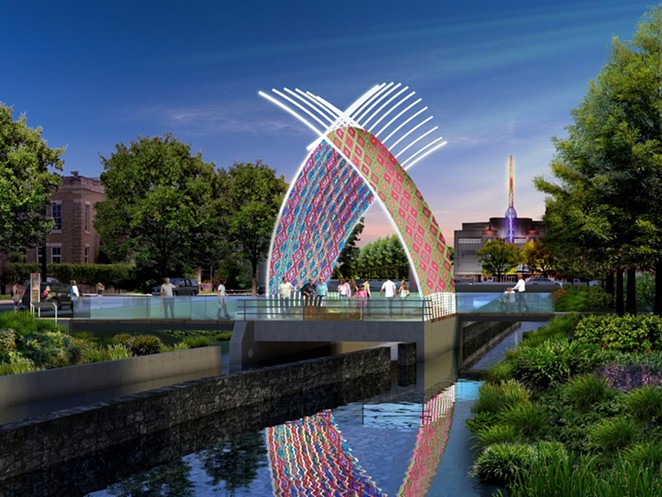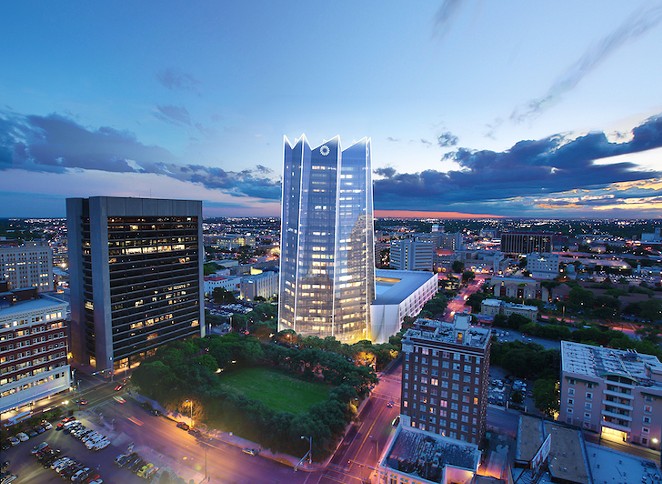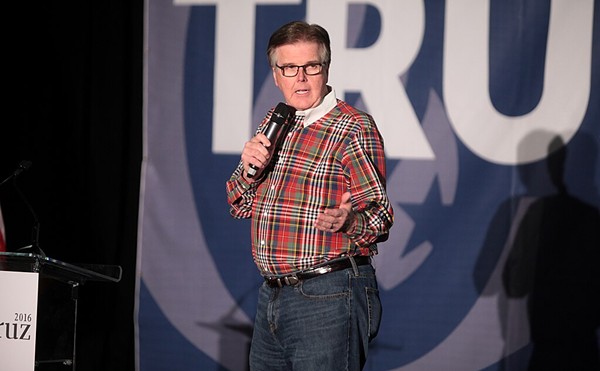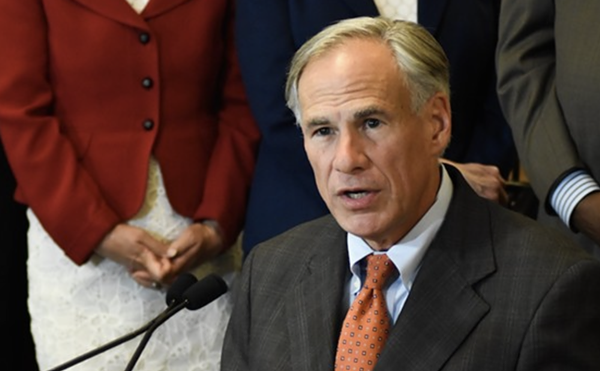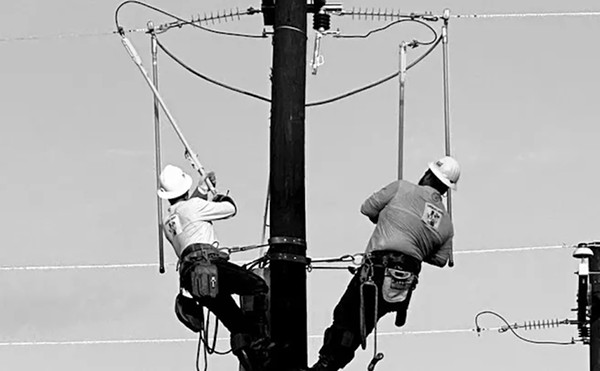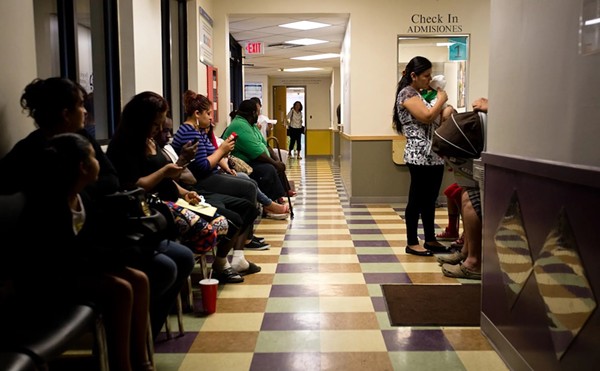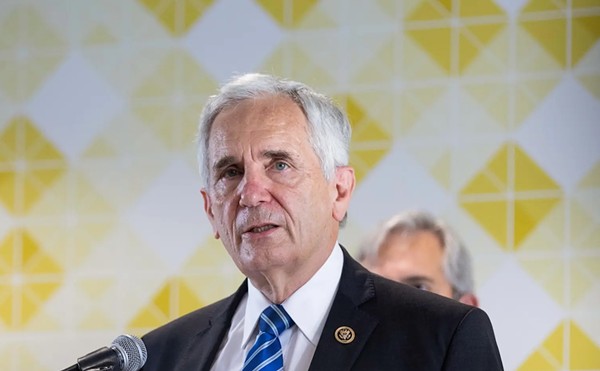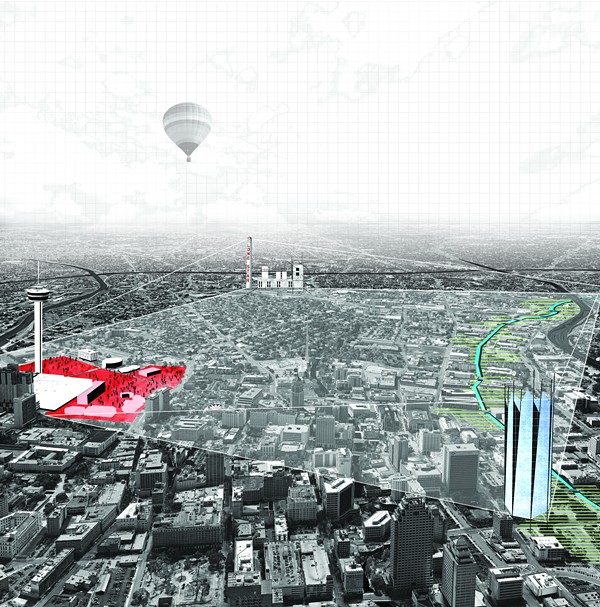
Before the Obama Administration snatched him up for a cabinet position in 2014, Julián Castro seemed determined to make sure he was the kind of mayor people remembered. Not only was he the youngest mayor of a major American city but, just three years in, he’d already managed to get voters to pass a $30 million sales tax to fund pre-kindergarten throughout the city. His fame grew when he was handpicked to be the first Latino ever to deliver the keynote address at the Democratic National Convention in 2012.
But Castro also tried to make his tenure a turning point in the city’s history of development, bringing back the big-picture “visioning process” with something he called SA 2020, a roadmap for a growing city that he started to roll out in 2010. When the official SA 2020 plan was finished and launched the following year, Castro called the document “a set of aspirations for our city, the dreams we have for ourselves.”
Among those dreams was a plan to curb suburban sprawl by reinvesting in an urban center that the city had long neglected. Sure, the convention and tourism trade made lots of money off the River Walk, Alamo Plaza, the Henry B. Gonzalez Convention Center and a downtown skyline that had pretty much been turned over to hotels. But if you looked closely, the center of town had become a rather bleak place. Residents fled the urban core at the turn of the 21st century. Even if San Antonians wanted to live downtown, there were few options. A stroll through most of downtown’s major corridors took you past entire blocks of empty storefronts. Abandoned office space occupied empty buildings across the heart of the city.
So Castro declared what he called a “decade of downtown,” a time when public money would goose private investment and help subsidize a move back to San Antonio’s urban and core neighborhoods.
Now, as the end of that decade fast approaches, city leaders have approved another big-picture plan that they say builds on the work Castro started. Launched in 2014, SA Tomorrow is supposed to be a long-range, comprehensive set of priorities that guides the city as it figures out how to handle the breathtaking population boom expected to hit the region in the coming decades. Currently, some 1.9 million people live in Bexar County. Officials predict that within the next 25 years, the county will grow by 1.1 million people.
Earlier this month, the day before City Council passed an SA Tomorrow plan that continues to call for redevelopment and more densely populated neighborhoods in the urban center, council members heard some of the first details of another plan that could dramatically change what the city looks like in the coming years. City staff laid out funding recommendations for what would be San Antonio’s largest-ever bond program if voters approve it next year. While city staff, as expected, proposed that the vast majority of the near $1 billion bond go toward basic infrastructure improvements like street, bridge and sidewalk repair, they also asked that a $330 million chunk go toward so-called “transformational” projects that they say have the potential to change the city in a fundamental way.
Not all of that “transformational” money is expected to flow downtown (for instance, the city asked that some $15 million go to build a land bridge where Wurzbach Parkway currently splits the north side’s Hardberger Park in two). But much of it – about $200 million – could go to projects that aim to remake the face of downtown in the coming years. That includes the complete remaking of a two-mile stretch of San Pedro Creek that lines the western edge of downtown, or the next phase in rebuilding what was once downtown’s crown jewel: Hemisfair Park.
Naturally, you can’t throw millions of public dollars at redeveloping huge swaths of the city without some accompanying tension. The march of restaurants, new housing and young professionals into near-east side and south side neighborhoods has brought with it the usual fears that residents who stuck it out during a period of neglect might now be priced out in the years of plenty. Then, in late 2013, came what many considered a dark omen: The first residential complex to be built in downtown proper during Castro’s so-called “decade of downtown” also razed the 1955 Univision building, once home to the nation’s first-ever Spanish-language television station.
But during a bond presentation earlier this month, Mayor Ivy Taylor insisted the vision laid out in SA Tomorrow and the massive amount of bond money the city is recommending to transform downtown signals a course correction away from suburban sprawl and toward a more modern city.
“In some ways, we’re kind of battling against history,” she told council members. “You go back some decades and some parts of town didn’t receive some of the attention that was needed, and so now we’re still trying to play catch-up. I think that’s what makes this conversation difficult. Acknowledging that is definitely going to be an important next step.”
Somewhere at the nexus of these hopes and concerns is an area of downtown the city has fought for years to resuscitate: Hemisfair.
When it comes to development, Hemisfair is one of the city’s original sins.
In order to transform the site into an urban park that would host the 1968 World’s Fair, developers demolished some 1,200 homes in what would eventually become the park’s footprint. In creating the hallmark of San Antonio’s skyline, the city destroyed a working class neighborhood.
Once the big celebration came and went, the park largely sat neglected for decades. It eventually became a dumping ground for the federal government and the University of Texas system. Andrés Andujar, CEO of the Hemisfair Park Area Redevelopment Corp., a nonprofit the city has tasked with managing the park, says the goal now is to “return to pre-1968 density. … It’s all about building a neighborhood, putting residents back into that district.”
Andujar insists Hemisfair is close to delivering on that promise. Five years ago, when the city allocated some $30 million of its bond proposal to Hemisfair redevelopment, not much had changed within the Hemisfair footprint in decades. Then in October 2015, HPARC completed the first of three phases when it unveiled Yanaguana Garden, a new 4-acre park lined with rehabilitated postbellum homes that the city plans to lease out to restaurants and shops. Yanaguana’s first tenant, Paleteria San Antonio, opened this summer. Andujar says surveys at the park commissioned by HPARC show some 440,000 people have visited Yanaguana since it opened.
“We think that’s confirmation that redevelopment at Hemisfair will be wildly successful,” he told the Current.
HPARC’s next phase is to build what Andujar says will be the hallmark of the new Hemisfair district: a giant civic park on Hemisfair’s northwest corner lined by shops, cafes, apartments and even a hotel. It will replace the wing of the convention center that was demolished and is currently being rebuilt (only slightly bigger and with more modern amenities), closer to the highway in the largest development contract ever given by the city for a capital improvement project.
Zachry Corp., part of the partnership handed $325 million to demolish, rebuild, and expand the convention center, is now one of the companies that has entered into negotiations with HPARC for a $165 million high-rise development on the edge of the new civic park. Andujar says the idea is to bring apartments, retail, offices, and even a 200-room “boutique” hotel.
The hotel has become a flashpoint of sorts for activists and groups that have criticized the city’s development policies. David Zachry sat on the HPARC board in its earliest years of existence. In 2013, he successfully lobbied the Texas Legislature to tweak a state law that ultimately allowed for the building of a hotel at Hemisfair in the first place. Danna Schneider with Unite Here, the local hotel workers union, continues to characterize the Hemisfair hotel project as a public giveaway to developers. In an email blast she sent out to supporters this summer reiterating the group’s opposition to a hotel at Hemisfair, she wrote, “Let’s be honest: a hotel in our public park does not improve our quality of life.”
Andujar, meanwhile, insists that kind of development is necessary to build and sustain the type of district HPARC has imagined for Hemisfair. And while the civic park is central to the next phase of revitalizing Hemisfair, it’s not clear where all of that money will come from. Andjuar puts the price of the civic park itself at $58 million. So far philanthropy, through the Hemisfair Conservancy, has only pulled in about $800,000, Andujar says, meaning that if the city really keeps its bond funding for Hemisfair at the current recommendation of $26 million, planners might have to bridge a major funding gap.
All told, Andujar doesn’t seem too worried about that. He told us HPARC might push for the city to pitch a separate $18 million bond based on what HPARC thinks it could pull in revenue from businesses leasing land around Hemisfair in the coming years. Plus, he says, HPARC is brainstorming “creative” ways to raise money.
Like selling off naming rights to sections of the emerging district. Andujar promises the district will forever be known as Hemisfair — “that’s not for sale,” he assured us. But you could rename Yanaguana Garden for the next 25 years for a cool $5.8 million.
On the menu for naming rights is also the new civic park that Andujar says is so critical to Hemisfair’s future. For $10 million, you get to name the flagship of the new and improved Hemisfair.
While the Tobin Center for the Performing Arts was mostly made possible with $100 million in public investment through the 2008 bond, the Tobin Endowment got to name it for a $15 million donation that nudged the project into the end zone.
What historic preservationists said they didn’t know at the time was that the new performing arts center would replace and demolish the city’s Municipal Auditorium, where in 1939 labor leader Emma Tenayuca escaped a violent mob by sneaking out through the building’s bowels and underground passages. After a brief legal fight with preservationists (including Tenayuca’s niece and Carmen Tafolla, a former poet laureate to the city and state who argued that the building was historic and worth saving), the city tore it down anyway, but kept the facade of the old historic building. Preservationists jokingly called it “façadomy.”
Still, people like Centro CEO Pat DiGiovanni call places like the Tobin “catalytic” projects that can transform entire areas of a town. DiGiovanni said the downtown economic development nonprofit gathered “stakeholders” (developers, business owners and others with a vested interest in downtown development) and came up with their own funding recommendations for a number of large-scale projects they would like to see to get significant public funding through the 2017 bond.
City staff recommendations mirror almost all of Centro’s, save for funding for Hemisfair that comes in significantly below what Centro had requested (they wanted the whole civic park project to be fully funded by the bond). That includes some $36 million for improvements along San Pedro Creek downtown that are being spearheaded by the San Antonio River Authority and Bexar County. Officials estimate the project, which is set to break ground early next month, will carry a price tag of about $175 million, $125 million of which the county has already committed.
While it’s unclear where the rest of that money will come from, what is quickly becoming obvious is that renewed public funding of downtown projects is starting to attract developers. As the San Antonio Express-News first reported earlier this month, developer giant Weston Urban, co-founded by local tech entrepreneur Graham Weston, has been gobbling up properties near the proposed San Pedro Creek expansion on the northwest corner of downtown for the past year and a half.
Weston Urban and another emerging player in downtown development, GrayStreet Partners, have been on a buying spree in and around a six-block stretch of Houston Street that’s been barren for most of recent memory. Local tech-industry boosters with Tech Bloc have even started calling it the city’s first tech district, giving it the hashtag #SATD.
Details for what is perhaps one of bolder proposals for downtown to emerge in recent memory came this summer when Weston Urban unveiled its plans for the first major addition to the city’s skyline in 27 years. The proposed 400-foot Frost Bank Tower at the corner of Flores and Houston streets, backed by some $1 million in city incentive and fee waivers, cleared the city’s historic design and review commission earlier this summer. Some commissioners wondered whether Weston Urban should try to make the 23-story building even taller. The new skyscraper is part of a public-private partnership City Council approved last year that included spending $51 million to buy the old 22-story Frost Bank Tower on Houston Street, where the city plans to consolidate staff that are currently scattered across town.
DiGiovanni says he has another way of gauging a city’s health: coffee shops. “I look at the measure of success in terms of coffee shops,” he told us. “When I came here 10 years ago, there was hardly anything. And now look how many are showing up.” He ran through the list of San Antonio’s growing roster of coffee peddlers that aren’t Starbucks: Rosella, Brown, Local, Press, Sip, Halcyon.
If, like DiGiovanni, you judge us by our coffee shops, San Antonio is indeed a city on the rise.
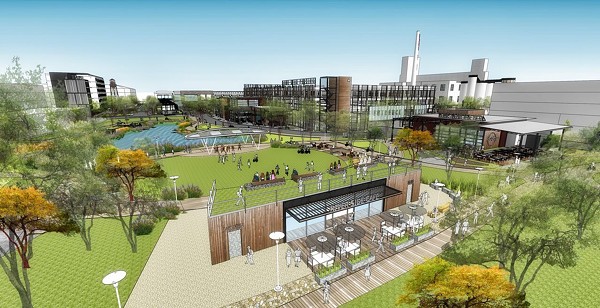
Around the turn of the 20th century, as the city’s streetcar system was built and expanded, so-called “streetcar suburbs” like Alamo Heights, Terrell Hills and Monte Vista started to spring up. Like every other major city, San Antonio saw residents flock to the edges of town during the rapid period of suburbanization after World War II. White businessmen under the banner of the Good Government League drove public dollars to north side developments where they built their own middle-class, mostly-Anglo neighborhoods.
Growth moved in a direction away from much of what made San Antonio unique. Express-News reporter Vianna Davila, who spent more than a year investigating the city’s history of development and leaders’ plans for the future, recently delivered this sobering assessment of how we got to this point: “As it has increased in size, San Antonio has grown away from its historic origins downtown and on the South Side, the respective homes to San Fernando Cathedral and the missions. It’s as if in the process of becoming the seventh-largest city in the country, San Antonio has drifted away from the core of what has made it special and different than any other American metropolis.”
But now, redevelopment has begun along the edges of the east and south sides, and there are already indications city builders are eyeing the west side as another spot in need of “transformational” development. Earlier this year, it was reported that a yet-unnamed developer is under contract to buy the 2.6-acre Scobey complex on the near west side with plans to turn it into a mixed-use development.
Former Express-News editor Bob Rivard, who perhaps more than anyone else in local media has his finger on the pulse of local movers, shakers and developers in this city, recently championed this particular vision for the west side: “Done right, it’s [sic] unique Spanish/Mexican/Mexican-American essence will make the west side of downtown a magnet for locals and visitors alike in search of a contemporary experience built on cultural authenticity.” Rivard also called for the city to just add more money to the already record-setting bond proposal in order to fully fund the next phase of Hemisfair.
This summer, just as the city started the process of carving out bond funding for major redevelopment projects in and around downtown, we got a fresh reminder of how efforts to rebuild an urban core for locals can quickly go off the rails. Last week, the city was forced to essentially hit the reset button after its nascent plans for Brackenridge Park spooked citizens because they would have radically changed the nature of the cherished public space. City officials have asked that the citizen bond committees, which are tasked with massaging the bond proposal before it goes to voters, fund Brackenridge redevelopment to the tune of $19 million.
It’s likely public dollars will eventually follow other “transformational” projects, like the redevelopment of the old Lone Star Brewery on the edge of Southtown, a project by private developers Aqualand of San Marcos and CBL and Associates out of Chattanooga, Tennessee.
Aqualand President Adam Schneider acknowledged the project’s obvious similarities to the redevelopment of the old Pearl brewery along south Broadway. Lone Star, he told us, will probably be less food-centric and more focused on becoming an entertainment hub for the city (they’re still hammering out exactly what that means, he said). He says there will be mixed use, retail, office and residential — possibly even a hotel. The developers say they plan on going after some of the city’s downtown housing-incentive money.
David Neuhoff of CBL says the idea is to “create another destination point not just for Southtown but for the city as a whole.” He says the developers plan to start construction next year and open by fall 2018.
Neuhoff acknowledges that the timeline sounds ambitious. But he says the continued discussions among city leaders about urban redevelopment has given them “a lot of momentum.” He echoed the increasingly common parlance of urban transformation here. “A great project to create a destination for Southtown itself and all of San Antonio. … A wide-reaching project for the whole city.”
[email protected]
Mark Reagan contributed reporting

